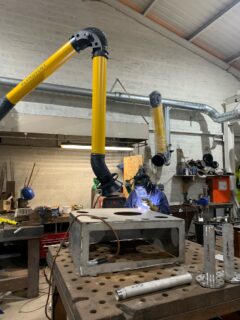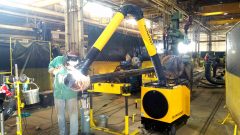When welding, proper positioning of the extraction arm is paramount to ensure safety. The extraction hood should be placed diagonally approximately 30cm above the welding point. This ensures that harmful fumes are extracted from the breathing zone, creating a well-ventilated work area for the welder. Our extraction arms come equipped with user-friendly support mechanisms that feature large handles, making adjusting the hood's position effortless. By following these guidelines, you can guarantee a safe working environment while welding.
Welding fumes pose significant risks to both short-term and long-term health. Acute and chronic health issues, including lung cancer and occupational lung disease, can result from exposure to welding fumes. Furthermore, the eyes and skin can be harmed by such exposure. When welding in confined spaces, there is also the risk of asphyxiation. To ensure compliance with the Control of Substances Hazardous to Health Regulations 2002 (COSHH), taking appropriate measures and actions to mitigate these risks is crucial.
We highly recommend watching the video we've included in the link to gain additional insights on properly positioning the welding extraction arm. Moreover, there are multiple other alternatives accessible for fume and dust extraction, including on-torch extraction, extracted benches, extracted booths, and movable LEV. Remembering the possible health hazards linked with welding fumes, such as occupational lung disease and skin and eye damage, is crucial.
To ensure the safety of yourself and those around you, it's vital to remember that welding in enclosed areas could lead to suffocation. To comply with the Control of Substances Hazardous to Health Regulations 2002 (COSHH) and prevent any harm, it's crucial to take all necessary precautions to minimize potential risks. Always prioritize safety and be sure to follow the appropriate guidelines.
How to position a welding extraction arm
The hood should be placed around 30cm diagonally above the welding point.
The fumes should be extracted away from the operative breathing zone.
Positioned correctly, it should not obstruct the welder's working zone.
Our extraction arms are equipped with support mechanisms that are easy to move into position using the large handles.
Several options are available when it comes to controlling fume and dust in industrial settings. These include on-torch extraction, which involves extracting fumes and dust at the source of welding or cutting; extracted benches, which are designed to collect fumes and dust from workstations; extracted booths, which are essentially enclosed workspaces that are fitted with exhaust systems to remove contaminants; and movable Local Exhaust Ventilation (LEV) systems, which can be moved around as needed to capture fumes and dust from various sources. Each option has its advantages and disadvantages, and selecting the right one will depend on factors such as the size and layout of the workspace, the type of work being carried out, and the specific hazards that need to be addressed, re various fume and dust extraction options, including on-torch extraction, benches, booths, and movable LEV.







Comments